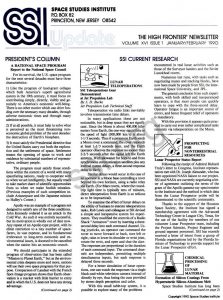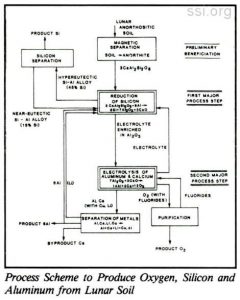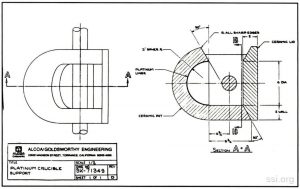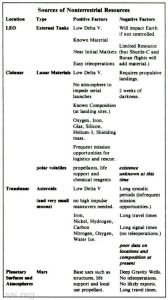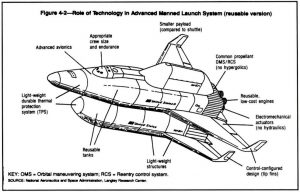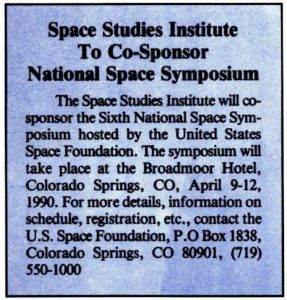SPACE STUDIES INSTITUTE
P.O. BOX 82
PRINCETON, NEW JERSEY 08542
[[librarian note: This address is here, as it was in the original printed newsletter, for historical reasons. It is no longer the physical address of SSI. For contributions, please see this page]]
SSI UPDATE
THE HIGH FRONTIER® NEWSLETTER
VOLUME XVI ISSUE l JANUARY/FEBRUARY 1990
PRESIDENT’S COLUMN
A RATIONAL SPACE PROGRAM
Report to the National Space Council
For its survival, the U.S. space program for the next several decades must have three characteristics:
1) Like the program of land-grant colleges which built America’s superb agricultural system in the 19th century, it must focus on contributing simply, directly, visibly and genuinely to America’s economic well-being. There is no other motive which can drive funding over the necessary many decades, through adverse economic times and through many administrations.
2) If at all possible, it must help to solve what is perceived as the most threatening noneconomic global problem of the next decades: the destruction of Earth’s biosphere.
3) It must satisfy the Presidential directive that the United States carry out both the exploration and the settlement of space. Settlement means the opening of space to work and residence by substantial numbers of representative, ordinary people.
The program must satisfy those conditions within the context of a world with many spacefaring nations, ready to cooperate with us when we act intelligently, but equally ready to take market share of scientific opportunities from us when we make foolish mistakes. (Previous examples of such competition include Arianespace and the Japanese mission to Halley’s Comet.)
Apollo was an example of a program not designed to satisfy any of the three conditions. John Kennedy ordered it as an attack in the Cold War. As such it was entirely successful, but its motivation is wholly out of date now. Any repeat of an Apollo-type project, with its elitist restriction to a tiny number of spacefarers, its vast expense, and its fundamental irrelevance to long-term economic and environmental issues, is doomed to be cancelled when the nation hits an economic crunch.
We should participate in the extended program of observation that has been called “Mission to Planet Earth,” but as the environmental crisis deepens more and more, nations will use their own space programs for that purpose. Comparison of Landsat with the French Spot-Image program shows that Earth observation is a market with little barrier to entry and in which the U.S. does not have any strong advantage.
We have the opportunity now to lead the way with a program that satisfies all three conditions. That program is the development of the technology for building and operating solar power satellites to supply clean energy to all the nations of the Earth. For economic practicality, that program must include processing lunar surface materials for their content of oxygen, silicon, metals and glass.
The power satellite program is great enough in scale to justify properly and legitimately a NASA program of large size and long, assured duration, concentrating on technology development and prototype systems. The potential market for new electric generating stations even today is some $250 billion per year. Fifty years from now, when that program could reach full maturity, the market worldwide could be $6 trillion per year. That estimate assumes no more than the United Nations estimates for world growth in population and industrialization, combined with a gradual shift over half a century from fossil fuels to power derived from solar satellites.
The power satellite program satisfies all three conditions above. It gives the U.S. leading market share in a market of great size. By providing energy that is clean and free of both fossil fuel emissions and nuclear wastes, it does not simply examine passively the destruction of the biosphere but can save the biosphere from that destruction. In that sense it is the ultimate “Mission to Planet Earth.” By its scale, and its corresponding need for human beings with a variety of skills and specialties working in space, it will lead naturally to the settlement of space, in accord with the Presidential directive.
We cannot, nor should we, expect that the program will be carried out by the U.S. alone. Japan and the Soviet Union are already actively interested in it, and our goal should be to lead an international effort. Our timewindow of opportunity, while we still retain enough advantage in space technology to play that leading role, is probably not much more than five years.
There are two excellent examples in which we did in fact supply NASA-developed technology to what are now successful, profitable international consortia. The first is Intelsat, and the second is Inmarsat. We should plan the power satellite consortium on a sound business basis, with its main operational startup funding coming from private investment rather than from tax dollars. Prior to that . operational start-up, funding for technology development must be governmental, because the time scale is much longer than the five to ten year maximum which is saleable to private investors. After the consortium becomes profitable, it should feed large royalties back to the governments which developed its technology.
Leading the way to what will be by far the largest space industry of the early 21st century will require that our nation develop an entire infrastructure of transportation, materials processing, teleoperation, robotics, and methods for economical work in space by humans. That infrastructure, developed over decades with solid economic and humanitarian goals, is the same that will enable, with little additional effort, exploration of the solar system on a scale far beyond anything contained so far in NASA documents. The proudest scientific program of all may well be voyages in space of ships that will be home to many scientists, crew members and their families. They will orbit Mars and Venus, and their successors will venture still farther into our solar system. They will be the 21st century equivalents of Darwin’s “Beagle.” And like the Beagle, their voyages will still be a source of pride and wonder more than one hundred years later.
Representative citizens of all professions and skills, moving into space with their families to take jobs in the solar power satellite industry, will be the first real space generation.
Their descendants, together with people emigrating directly from Earth, will move outward in the solar system as many of our ancestors moved Westward in the 19th century. America was the land of opportunity and freedom for our ancestors, and settlements in space will open a limitless frontier, rich in solar energy and materials, where American ideals of freedom and economic opportunity can flourish in the 21st century and beyond.
Gerard K. O’Neill
LUNAR TELEOPERATIONS
SSI Teleopentions Gear Demonstrated at Jet Propulsion Lab
By J. D. Burke Jet Propulsion Lab Technical Staff
Teleoperation via radio links inevitably involves transmission time delays.
In many applications these are not noticeable, but in deep space they are significant. Since the Moon is about 400,000 kilometers from Earth, the one-way signal time at the speed of light (300,000 km/s) is about 1-1/3 seconds. Thus if a person on Earth sends a Moon rover a command, the rover responds at least 1-1/3 seconds later, and the Earth operator observes the response no sooner than 2-2/3 seconds after the signal left the Earth antenna. With allowance for hops to and from synchronous communication satellites plus any internal system delays, a three-second response delay is likely.
Similar delays would occur in the case of an operator in a Moon base controlling a rover beyond his own horizon, using a radio relay via Earth. (For Mars rovers, where the roundtrip light time is typically tens of minutes, direct teleoperation from Earth is so tedious as to be impractical).
To examine the effect of lunar delays on the ability of humans to execute telcoperations tasks, Rob Lewis and colleagues at SSI devised a simple and inexpensive system for experiments. They modified the controls of a Radio Shack “Armatron” rover by inserting a three second delay into each command channel. Using joysticks, an operator can command the rover to move forward or back, turn left or right, raise or lower its shoulder or wrist joint, rotate the wrist, and open and shut the claw. The responses are proportional to the duration of each command input. The command channels are independent, permitting multiple simultaneous inputs, but each response is delayed three seconds.
For a better simulation of lunar operations, one can watch the responses via a single black-and-white television camera instead of directly by eye, thus losing the cues provided by stereo depth perception and color.
With this small table-top system, it is possible to explore many of the problems encountered in real lunar activities such as those of the Surveyor landers and the Soviet Lunokhod rovers.
Numerous test runs, with tasks such as negotiating mazes and stacking blocks, have now been made by people from SSI, the International Space University, and JPL.
The general conclusion from such experiments, with both skilled and inexperienced operators, is that most people can quickly learn to cope with the three-second delay. Operator fatigue is an important source of errors, and hence frequent relief of operators is mandatory.
With this provision it appears quite practical to carry out even rather complicated tasks remotely via teleoperations on the Moon.

PROSPECTING FOR NON-TERRESTRIAL RESOURCES
Lunar Prospector Status Report
Following the receipt of Admiral Richard Truly’s letter to Congress, Institute representatives met with Dr. Joseph Alexander, who has been appointed NASA liaison to our project. SSI and NASA are currently negotiating a letter of agreement outlining the terms of the grant of the Apollo gamma-ray spectrometer to the Institute and the method in which data from the Lunar Prospector probe will be disseminated to the scientific community.
Thanks to the support of the Houston Space Society, the Institute has signed a membership agreement with the Advanced Technology Center in League City, Texas, for the use of the facility for members of our volunteer Lunar Prospector team, including the Project Scientist, Project Engineer and ground segment personnel. SSI has recently received a letter of intent from a group of Florida organizations led by the Florida Institute of Technology to provide support for the Lunar Prospector effort.
CHEMICAL PROCESSING OF LUNAR MATERIAL
Formation of Silicon Coatings From Hypereutectic Silicon-Aluminum Melt
Space Studies Institute has long been interested in electrolytic production of oxygen, silicon and aluminum from lunar soil. Under the direction of Rudolph Keller, EMEC Consultants has developed a process scheme to produce these products from lunar anorthite. The overall process, as described in the 1989 Space Manufacturing Conference proceedings, is illustrated below.
The present work, which will be completed during Spring 1990, explores the production of silicon coatings directly from the hypereutectic silicon aluminum melt, which is an intermediate product of the process. In laboratory experiments hypereutectic silicon aluminum alloy will be cooled while providing a substrate for the crystallization of the silicon. If coherent coatings can be produced, their use in areas such as the production of solar cells for space power generation will be evaluated.
PHYSICAL PROCESSING OF LUNAR MATERIALS
Solar Powered Glass/Glass Pilot Plant
Construction is now underway on the solar powered glass/glass pilot plant being built under joint agreement between the Space Studies Institute, Alcoa/Goldsworthy Engineering and McDonnell Douglas Corporation. McDonnel Douglas is working on the space frame attachment and pillow block. This will support the glassmaking equipment at the focal point of the ten and a half meter concentrator located in Huntington Beach, California. Alcoa/Goldsworthy Engineering has designed the ceramic support device for the platinum crucible which will contain the glass melt in the first phase of pilot plant operations (see drawing right).
The actual platinum crucible support is presently being fabricated at the Alcoa Technical Center in Pittsburgh. Appropriate simulants for initial experiments are also being procured.
VICE PRESIDENT’S COLUMN
LAUNCHING INTO THE NINETIES
The 1990s will be a tremendously exciting period for the Space Studies Institute. Thanks to President Bush’s July pronouncement, making the exploration and settlement of the solar system official United States policy, we are seeing a large upswing in activity. The new National Space Council, which has been tasked by the President with formulating concrete plans for US space strategy, has actively solicited the Institute’s input. We have had several meetings with the Council staff and have established an ongoing dialogue with them.
This month’s President’s Column by SSI founder Gerard K. O’Neill is representative of our input to the Council on the characteristics of a sustainable space program.
Research Trends
Dr. O’Neill and I recently prepared a paper for the International Astronautical Federation (IAF) Annual Conference in Malaga, Spain this past October entitled, “Trends in Nonterrestrial Resource Development.” ln this paper we surveyed the sources of nonterrestrial materials available in the solar system (see box right). One of the most striking features of nonterrestrial resources is that some of the most exciting resources are speculative in nature. For example, lunar polar volatiles could dramatically enhance human spaceflight and outpost capabilities. Therefore, SSI has set a very high priority in answering the question of their existence (see Lunar Prospector status report under Prospecting for Nonterrestrial Resources in this issue).
Asteroid data is also quite sparce. Thanks to the work of people such as Glo Helin, Mr. & Mrs. Eugene Schumacher and Tom Gehrels, many asteroids have been discovered in recent years. However, data on asteroid locations and compositions is generally poor. For example, asteroid 1982 DB, often suggested as a favorable mission candidate for resource utilization, is now “lost in space.” The Institute has set a high priority on asteroid location and characterization activities. Institute Trustee James D. Burke, SSI Senior Advisor Richard Bouldreault, Lunar Prospector Leader Gay Canough and I wrote a proposal to the International Space University (ISU) suggesting that it devote one of its two design projects during the 1990 summer session in Toronto, Canada, to an international asteroid mission design. ISU has advised us that they have accepted this proposal, and we are in the process of jointly designing this summer project, which will look at asteroid search strategies in addition to mission planning and resource recovery analysis.
New Chemical Processing Research
In addition to examining resource location and characterization needs, our IAF paper discussed trends in the processing of nonterrestrial materials. We concluded that simple robot processing techniques will be of the greatest near term interest in producing commercial products from lunar materials. One particularly promising method involves electrolytic techniques (of the sort used in terrestrial aluminum processing) to extract oxygen, aluminum and silicon from lunar materials. One of the leading experts in this work is SSI Senior Associate Dr. Rudolph Keller of EMEC. I am pleased to announce that the Institute and Dr. Keller have entered into an agreement on the formation of silicon coatings as a product of electrolytic lunar processing. For further details see announcement under Chemical Processing of Lunar Materials in this issue.
The Institute has been experimenting with the use of interns to augment our staff and accomplish special tasks. We have enjoyed the exemplary services of three interns during the past semester. Dr. John J. Farrell, Professor of Chemistry and Director of the New Liberal Arts Project at Franklin & Marshall College, was an intern at SSI from September to December of 1989. Professor Farrell, while on sabbatical from his college, developed a new college level course for non-science majors, entitled Introduction to Space and Spaceflight. While at SSI he developed a Macintosh computer application in Super Card™ called Island One. Island One contains graphical and text information about Earth’s first space colonies as described in The High Frontier and has additional information on space transportation and solar power satellites. Dr. Farrell is currently completing documentation of the software which will be beta tested by Institute volunteers and made available for release later this year.
Mr. Eric Tilenius, a senior at Princeton University, has also just completed his fall internship at SSI. Eric is the President of the Princeton Planetary Society, an extraordinarily active and supportive group of Princeton students, which has been responsible for many excellent programs at Princeton University over the years. Members of this organization have, for example, contributed to SSI’s teleoperations experiments and provided assistance during the SSI/Princeton Conferences on Space Manufacturing. Eric’s work at SSI consisted of research into space policy and assistance in communication between the Institute and Congress during our successful quest for support for the NASA Apollo gamma-ray spectrometer.
During mid-1989 we were fortunate to meet Mr. Chris Farranetta, a local resident with an interest in scientific expeditions. Chris joined us as an intern to assist our Lunar Prospector project. In addition to excellent performance in producing graphics for the project, Chris became so indispensable to the office that we brought him on board initially as a part-time employee and now as a full-time assistant.
As a result of these positive experiences, we are continuing to work with Princeton University’s internship program and will accept applications for interns from outside the university community as well. If you are in a position to contribute a significant effort over a sustained period of time without pay, during regular business hours (Editor’s note: Sounds like a dream job to me!), feel free to apply. We are most grateful to John, Eric and Chris for their outstanding contributions to SSI’s mission!
Gregg Maryniak
Special Notice
A group of Soviet scientists, including Vlacheslav Filin, the Deputy Chief Designer of the Energia System, and Anatoly Mikheev, the Director of the Soviet Sail Project and the Energia Youth Center, are tentatively scheduled to visit the Space Studies Institute in March.
BOOK REVIEW
NEW RELEASE:
Round Trip to Orbit: Human spaceflight alternatives
by the Office of Technology Assessment Congress of United States
If you get any group of more than three space enthusiasts together for over five minutes, the subject of launch technologies is bound to come up. The Office of Technology Assessment’s new volume, Round Trip to Orbit provides the most comprehensive review of launch systems published to date. Shuttle modifications, the National Aerospace Plane and Crew Escape and Rescue Vehicles are covered as are SAENGER, HOPE, HERMES and HOTOL. With the exception of single stage to orbit vehicles of the sort discussed by Max Hunter (SSX) and Gary Hudson (Phoenix), nearly every potentially man-rated system is discussed in this compact volume. At $5.50, this is a must buy.
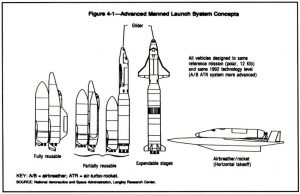
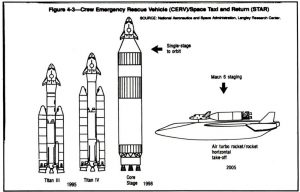
To order a copy of Roundtrip to Orbit: Human Spaceflight Alternatives – Special Report, GPO Stock Number 052-003-01155-7, please contact: Superintendent of Documents, Government Printing Office, Washington, DC 20402-9325. Order and information telephone number (xxx) xxx-xxxx. (Price, $5.50, includes domestic postage). International customers add an additional 25%.
©space studies institute

